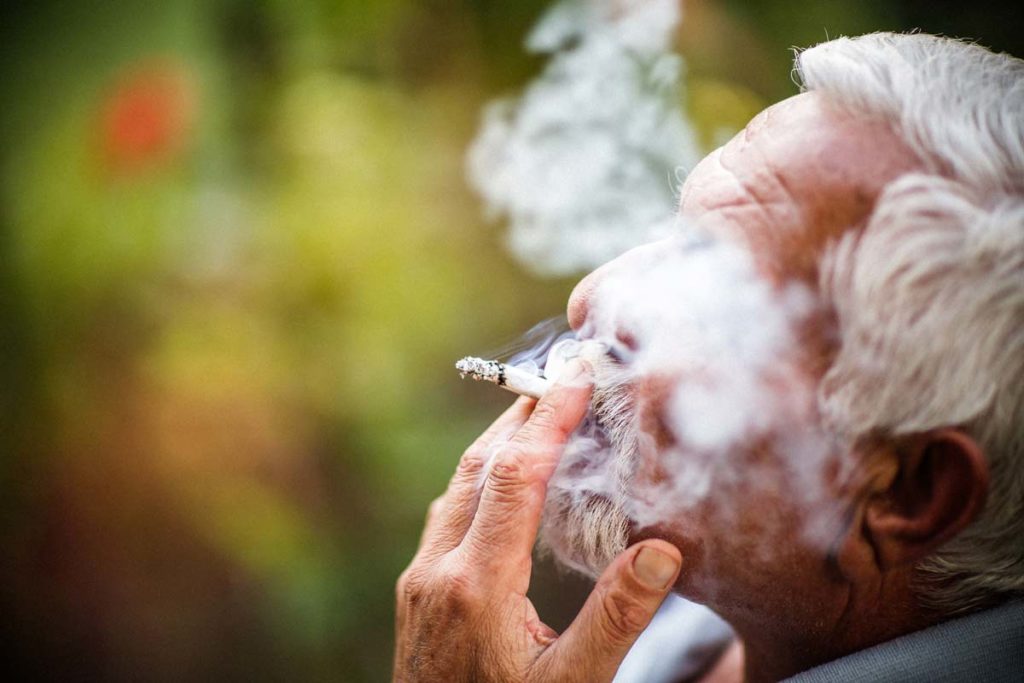When we refer to “smoking” throughout this article, this include people who inhale smoke from tobacco products like:
- Cigarettes
- Cigars
- Cigarillos
This does not include marijuana, which doesn’t cause the health issues associated with smoking tobacco (and other chemicals within tobacco products). This also doesn’t include smokeless products like chewing tobacco and spit tobacco, either, though these can have similarly severe health effects, especially on the mouth and gums. Lastly, when referring to “smoking,” we don’t include vapor products because there has not been enough research conducted on those products to see the long-lasting health effects they have on humans.
There’s no way to tell the exact number of people who smoke cigarettes, primarily because so many people do. However, the best estimates say that around 38 million people currently smoke.
So before we dig into how smoking affects an elderly person’s body, let’s look at how many people smoke.
Elderly Smoking Habits by the Numbers
There’s no way to tell the exact number of people who smoke cigarettes, primarily because so many people do. However, the best estimates say that around 38 million people currently smoke.
This means they have smoked at least 100 cigarettes and smoke at least one every day or so, according to the Centers for Disease Control. (CDC) About 17 percent of men smoke and about 13 percent of women regularly smoke.
Older people have the highest percentage of people who smoke, according to the CDC. These statistics include:
- About 18 percent of all people between 45 and 64 (the highest of all age groups)
- Around 9 percent of everyone between 65 and up
Different races, on the other hand, have different smoking rates. Native Americans (31.8 percent) and people with multiple races (25.2) have the highest rates while Asians (9 percent) and Hispanics (10.7 percent) have the lowest rates.
Smoking is one of the leading killers in the United States, too. Nearly 500,000 people die every year due to complications from smoking. That edges on one out of every five people who die.
One study found that 70 percent of all deaths related to smoking happened to people over 60. So while millions of people across all age groups smoke, it’s the elderly who eventually suffer the consequences.
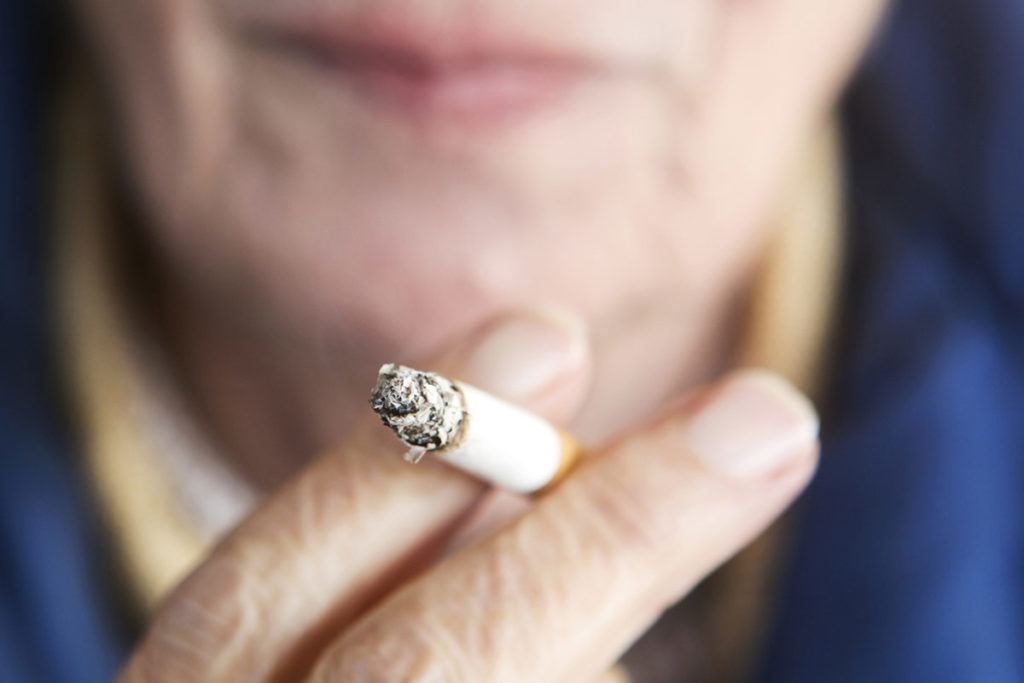
What Smoking Does to an Elderly Person’s Body
Cigarettes and other smoked tobacco products have a range of chemicals meant to keep you addicted to the product. At the same time, these products can slowly kill you, and the issues stemming from smoking can creep up quickly on an elderly person.
There are thousands of chemicals in these products, and they do viciously harmful things to your body, especially as you age.
The American Cancer Society says that some of the primary carcinogens—cancer-causing chemicals—in cigarettes include:
- Nicotine: The highly addictive chemical present in tobacco plants. It’s allegedly as difficult to quit as heroin.
- Lead: This is not a chemical you want to introduce any more of into your body than is already naturally present.
- Carbon monoxide: This is poisonous.
- Formaldehyde: It’s a toxic chemical used to treat wood and carpeting.
There are thousands of chemicals in these products, and they do harmful things to your body, especially as you age.
Some of the physical harm smoking can do to an elderly person’s body come in the form of:
- Dry skin/wrinkles: Smoking can dry out your skin and make it less elastic, which causes wrinkles.
- Thick, dark mucus: With all the harm that smoking does to your lungs, it can cause thick and coarse coughs. A byproduct of this is a darkened mucus that surfaces when your lungs are irritated, especially soon after you wake up.
- Erectile dysfunction: Smoking increases the risk of not being able to develop or maintain an erection.
- Less muscle: Smoking aids in the deterioration of or the lack of developing muscle due to the lower levels of oxygen flowing through your body.
Smoking also causes an overall weakening to your immune system due to the high potency of chemicals and sludge in the inner workings of your body. This makes it more difficult for your body to heal when severe and potentially fatal diseases and illness onset in your elderly life.
Debilitating Health Effects Stemming from Smoking
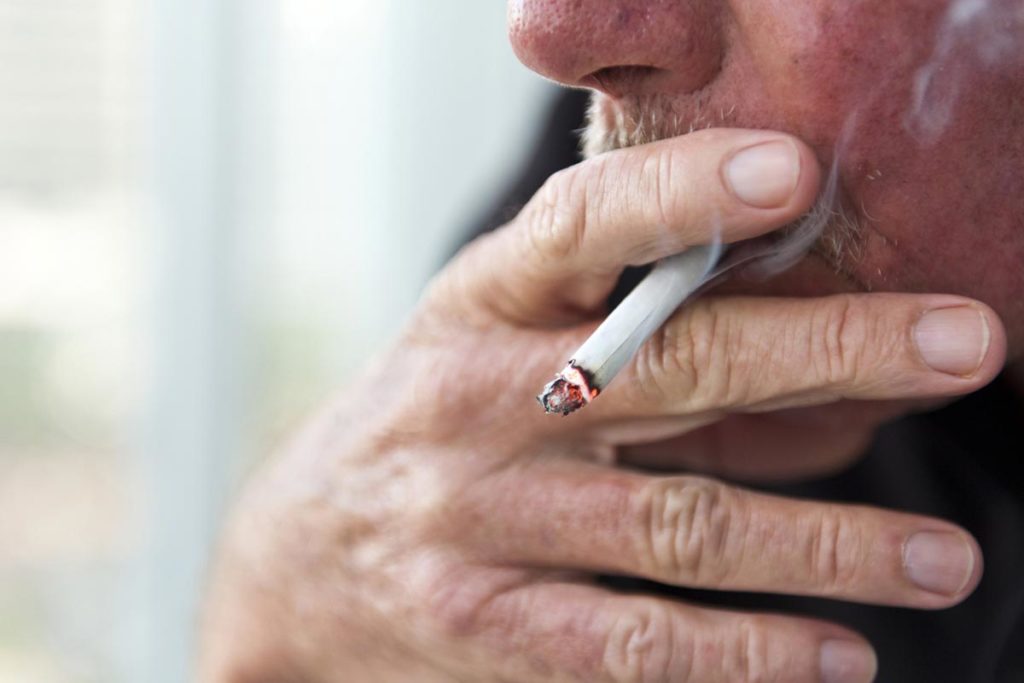
We primarily want to look into the extreme health effects smoking can have on an elderly person’s life. Years and decades of smoking can harm the body much more and far sooner than it should have with a life sans-smoking. This doesn’t mean you shouldn’t stop smoking—it’s never too late to start reversing the effects of smoking.
Years and decades of smoking can harm the body much more and far sooner than it should have with a life sans-smoking. This doesn’t mean you shouldn’t stop smoking—it’s never too late to start reversing the effects of smoking.
Smoking can aid the advancement of the following diseases and illnesses.
Diabetes
Type 2 diabetes—the most common form of diabetes—occurs when your body can’t produce enough insulin to break down all the sugar in your blood. This results in extremely high blood glucose levels. Diabetes has a host of health issues that come with it, including foot problems like numbness or the need for amputation, kidney disease, ketoacidosis (high level of toxic ketones), high blood pressure, and more.
The CDC reports that people who smoke are 30-40 percent more likely to develop diabetes. Smoking makes it more difficult for blood to travel throughout the body, especially to the legs, feet, and toes, which are already at risk with high levels of sugar in your blood.
Combine this with less oxygen and more toxins flowing through your blood, and diabetes could possibly onset sooner than it would have—if it even was going to onset at all. The chemicals in smoking products also make the body more resistant to insulin.
Cardiovascular Disease
This is one of the most fatal consequences of smoking.
Cardiovascular disease (CVD) is the leading cause of death of both men and women in the United States. It is an overarching term for any sort of disease or consequence that deals with how the blood flows through your arteries and veins, primarily within the heart.
Some of the types of diseases that fall under the cardiovascular disease branch include:
- Coronary artery disease: The most common form of CVD. This occurs when the coronary arteries—the main arteries of your heart—are damaged over time.
- Heart attacks: These occur when the arteries leading to and within your heart are completely blocked off.
- Strokes: These are similar to heart attacks in that there is a complete blockage, but strokes deal with the blockage of blood flow to your brain.
- Heart arrhythmias: This is an irregular heartbeat.
- Cardiomyopathy: This is the weakening of the heart muscle until it eventually stops working.
All of these forms of heart disease can onset or worsen due to smoking.
Cardiovascular disease is caused by a buildup of plaque within your blood vessels. This plaque often comes in the form of cholesterol. Cigarette smoke raises the levels of bad cholesterol (LDLs) in the body while decreasing the levels of good cholesterol (HDLs) at the same time. Smoking makes blood thicker, meaning it has a higher likelihood of clotting, too.
High Blood Pressure

Similar to how smoking increases the levels of cholesterol in the blood, which leads to various forms of heart disease, cigarettes and other tobacco products increase your blood pressure, which is another leading cause of cardiovascular disease.
When there is high pressure in your blood, it means that the blood is pushing against the walls of your vessels. Over a long period of time, this can cause damage to your blood vessels, and result in the following consequences:
- Coronary artery disease
- Strokes
- Heart failure
- Kidney disease
- Dementia (and the advancement of it)
- Aneurysm
Every instance of smoking increases your blood pressure. It can drop about 20 to 30 minutes after you’re done smoking a cigarette, but for those smoking a pack (20 cigarettes) a day, that means that your blood pressure is increasing and sometimes staying high throughout the whole day, which over time can damage the heart.
Cancer
Now, of the thousands of chemicals found in cigarettes, 250 of them have been found to be harmful and cause 69 forms of cancer, according to the National Cancer Institute. Many of these cancers onset in your elderly life.
Some of the most common forms of cancer caused by smoking are:
- Lung cancer: More than 80 percent of all lung cancer-related deaths are caused by smoking.
- Mouth/Throat cancer: The harmful chemicals from smoke can exist in your mouth and move all the way down your throat and esophagus to cause cancer.
- Kidney cancer: People who smoke are twice as likely to develop kidney cancer than non-smokers, primarily due to the damage smoking does to the blood vessels in the kidneys.
- Stomach cancer: A study in the United Kingdom found that 20 percent of all stomach cancers were as a result of the chemicals digested due to smoking.
- Liver cancer: Smoking can cause cancer in the liver despite never coming in direct contact with the organ.
The American Cancer Society notes that cigarette smoke causes almost half (48.5 percent) of all deaths by 12 types of cancer, including all the ones we just listed.
COPD
COPD (chronic obstructive pulmonary disease) is a lung disease that deals with restricted flow of air to and from the lungs. You can see on the surface how smoking would go hand-in-hand with the development of this disease, but let’s dig into what exactly it is and how smoking causes COPD.
The Mayo Clinic says that COPD is “caused by long-term exposure to irritating gases or particulate matter,” primarily smoke from cigarettes.
The Mayo Clinic says that COPD is “caused by long-term exposure to irritating gases or particulate matter,” primarily smoke from cigarettes, which makes smoking the number-one cause of COPD. In turn, the CDC notes that smoking could be the root cause of up to 80 percent of COPD-related deaths.
The smoke from tobacco products like cigarettes inflames (and potentially permanently damages) the air sacs in your lungs, making it more difficult for air to travel through your most vital breathing organs. This in turn leads to the following symptoms:
- Coughing
- Large mucus production
- Shortness of breath
- Blueing of the skin under the fingernails
- Wheezing
Once you develop COPD, even secondhand smoke can trigger these effects. COPD typically doesn’t onset until your late 40s or early 50s, with diagnosis rates peaking in both men and women in their 70s.
People with COPD are more likely to develop other diseases like lung cancer and heart disease.
Osteoporosis
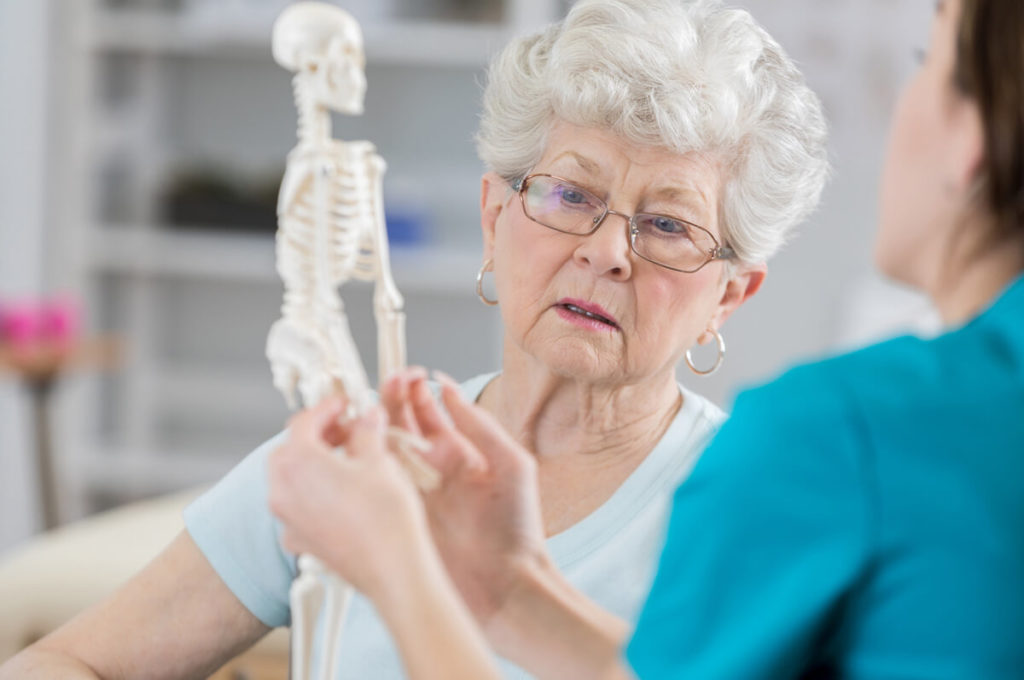
Smoking can cause a drop in bone density. If bone density gets too low, you may develop a condition called osteoporosis in which bones become weak, brittle, and easily breakable. This is a condition that severely affects the elderly, with 1 in every 10 women worldwide suffering from the disease.
Nearly nine million fractures occur in the United States every year due to osteoporosis, too, according to the International Osteoporosis Foundation.
The connections between osteoporosis, weaker bones, and smoking include other factors, such as the gender of the smoker, the amount of alcohol the person drinks, and their overall diet. Gender matters here because women are more likely to develop osteoporosis, and smoking can help induce a quicker menopause, which in turn can cause osteoporosis.
The chemicals in tobacco products can interrupt the bone reabsorption process, making it more difficult for your body to create bone while at the same time diminishing the bone that’s already present. This affects your bone density levels.
Tooth And Gum Diseases
Smoking is a leading cause of gum diseases and subsequent dental issues, according to the CDC.
As we’ve mentioned before, smoking weakens the overall effectiveness of your immune system. Your mouth, including your gums and teeth, is a vulnerable place for infections to enter the body, and smoking makes it easier for one specific illness, periodontal disease, to spread in the mouth.
Gum disease proliferates with germs and plaque, both which are present in cigarettes. As gum disease gets worse and goes left untreated, your teeth fall victim and eventually can rot and fall out.
The CDC also says that those who smoke have double the chance of developing gum disease as non-smokers and that treatment for gum disease (like surgeries and medications) don’t have quite the same effects as they do for non-smokers.
Eye Damage
Smoking can cause your vision to worsen and potentially turn into blindness.
The New York State Department of Health notes that smokers:
- Are three times more likely to develop cataracts, which are foggy areas in the lens of the eye. This makes vision cloudier and less clear.
- Can develop glaucoma from smoking. Glaucoma is a disease that occurs when the optic nerve of the eye is damaged, and it develops due to a high level of pressure in the eye. That pressure damages the optic nerve. The pressure can come from high blood pressure levels in the nerve and other tiny vessels in the eye. Smoking helps sustain and increase blood pressure levels, as we learned in the Cardiovascular section.
- Can have dry eyes due to smoking. Just as smoking dries out the skin, it can dry out the eyes and make it more difficult to see.
- Are three-to-four times more likely to develop age-related macular degeneration. This eye disease makes it more difficult to see smaller details, like the text in newspapers and on street signs. Even living with someone who smokes can increase your chance of developing AMD.
Conversely, smoking marijuana has been shown to help reduce pressure in the eye and ease the symptoms of glaucoma.
How to Quit Smoking at an Elderly Age
Quitting smoking is a difficult thing to do, but it can be especially difficult for elderly people. Why? It’s simple: they may have been smoking for three, four, even five decades by the time they decide they want to quit.
On top of the health benefits, an elderly person can save thousands of dollars every year if they quit smoking.
Interestingly enough, a study revealed that while younger people are more likely to try and quit, elderly people are typically more successful in their attempts than younger people.
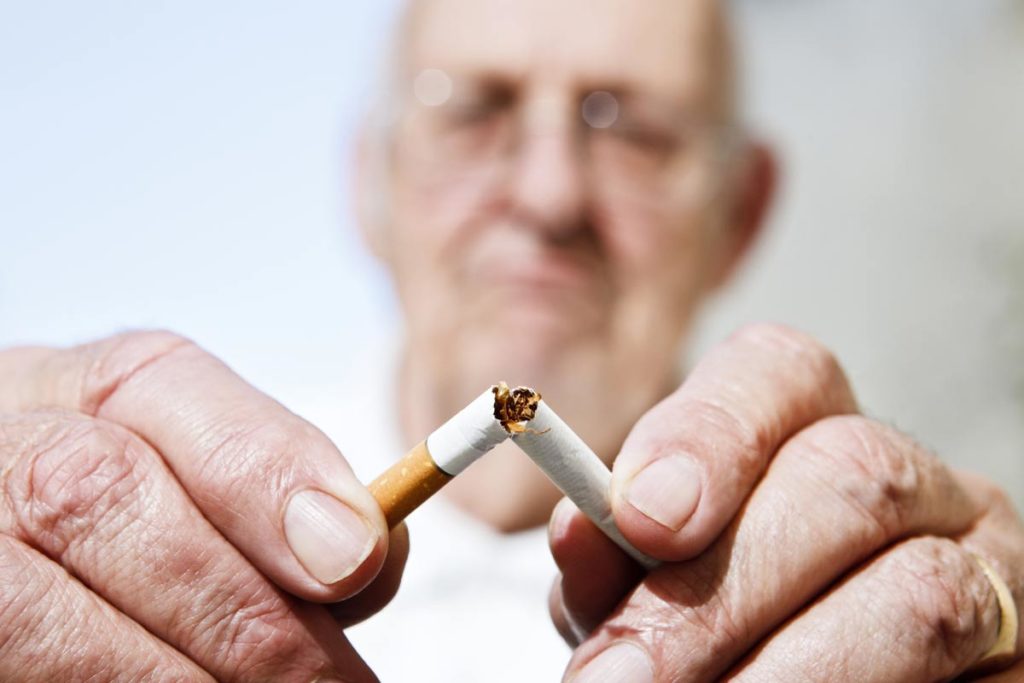
Remember: It Is Never Too Late To Quit Smoking.
Your health starts to improve less than 30 minutes after you give up smoking. The American Lung Association detailed what happens in the days, weeks, and years following quitting smoking, including lowering blood pressure and decreasing the risk of heart attacks.
Here are some specifics about how your life can change with quitting:
- After 20 minutes: Your blood pressure returns back to normal.
- After 24 hours: Go a full day without smoking a cigarette and you’ve lowered your chance of having a heart attack.
- After three days: Breathing becomes easier because your lungs aren’t constantly inflamed.
- After two weeks: Your overall lung function increases. Making it two weeks is a big step in quitting for good, too!
- After a couple months: Breathing continues to improve, and your chance of having a heart attack decreases by the week.
- After one year: Your chance of developing CAD is half that of a smoker’s chance.
- After three to five years: Your risk of dying of a heart attack returns to that of a non-smoker.
- After 10 years: Your chance of developing lung cancer decreases to that of a non-smoker.
On top of the health benefits, an elderly person can save thousands of dollars every year if they quit smoking. The average pack of cigarettes is between $6 and $8, depending on what state you live in.
Even taking the low-end estimate, if you smoke a pack a day, that’s over $2,000 every year. That money can go toward things like a new hobby, traveling the world, gifts for your kids and grandkids, and so much more.
Now, the hardest step with quitting is making it through the first few days and weeks. The nicotine is ever-present in your system, and it’s hard to fight the urge to smoke, especially if you decide to quit cold turkey.
Let’s dig through some routes you can take once you do decide it’s time to stop:
Ease Off
Going from smoking multiple packs a day to not smoking at all isn’t easy. For the first couple weeks, preparing yourself by lowering how much you smoke—primarily how often you smoke. Instead of smoking a few times in the morning, four times during daily activities, and a handful of times in the evening/night, try spacing it out to once in the morning, once or twice in the afternoon, and once or twice after at night, limiting each smoking session to one or two cigarettes per session. This may help you realize that you can break routines.
Cold Turkey
Some people want to power through the urge to smoke, and good on them! There are no risks of quitting smoking cold turkey, unlike with alcohol where you may have to ease off so you don’t risk fatal consequences. If you feel you can straight-up drop the cigarettes and not pick them back up, give it a try.
Seek a Companion
Again, quitting isn’t easy. Find a friend or family member who has been thinking about quitting as well, preferably someone you see or may smoke with. You don’t have to go through this alone, and companions can help keep each other in check.
Medication
There are medications that help you quit smoking. For instance, Chantix blocks the nicotine receptors in your brain with the goal of making you not want to even think about smoking, let alone crave a cigarette.
Patches and Gum
This treatment process focuses on replacing the addictive nicotine you’d get from the cigarettes with a far less harmful solution: using patches or chewing gum. These options come in varying strength that depend on how much you smoke, and you can decrease the dosage over time to wean yourself off.
Talk to Your Doctor
Your primary caregiver can give you a list of benefits even longer than the ones we’ve given you when it comes to quitting smoking. They may also be able to recommend other healthcare professionals like behavioral therapists who can help break the habit.
Reward System
When you don’t smoke a cigarette, reward yourself with a food or drink you really like. In the bigger picture, if you physically save up money for every pack of cigarettes you don’t buy, you can see all the money you’ve saved at the end of the year and spend it on something you want.
Quitting Services
As mentioned, it’s helpful to find a friend or companion to quit along with you. If there isn’t anyone like that in your life, there are services with thousands of people to help support you in your quest to stop smoking. Places like Quitter’s Circle and Freedom From Smoking provide the services and support you’ll need to put the cigarettes down.
If you’re an elderly person and have any other questions regarding the effects of smoking on your body or how you can best quit, contact your healthcare professional.
Do you want to cite this page? Use our ready-made cite template.
